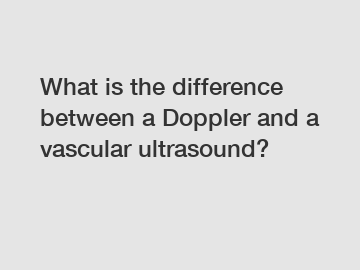What is the difference between a Doppler and a vascular ultrasound?
What is the difference between a Doppler and a vascular ultrasound?
Doppler and vascular ultrasound are two common imaging techniques used in medical diagnostics. While both techniques are used to visualize blood flow, they differ in their underlying principles and the information they provide.
Doppler ultrasound is based on the principle of the Doppler effect, which states that the frequency of sound waves changes when there is motion between the source of the waves and the observer. In the case of Doppler ultrasound, the sound waves are emitted by the transducer and reflected back from moving red blood cells. By measuring the frequency shift of the reflected waves, Doppler ultrasound can determine the velocity and direction of blood flow.

On the other hand, vascular ultrasound, also known as duplex ultrasound, combines traditional B-mode imaging with Doppler ultrasound. It not only provides visual images of blood vessels but also generates color-coded maps to represent blood flow velocity and direction. This technique uses the same principles as Doppler ultrasound to analyze blood flow patterns and detect any abnormalities such as narrowing or blockages in the blood vessels.
The main difference between Doppler and vascular ultrasound lies in the information they offer. Doppler ultrasound focuses solely on blood flow, providing information about velocity and direction. In contrast, vascular ultrasound provides a more comprehensive evaluation of the blood vessels, including their structure, size, and any potential blockages. It allows healthcare professionals to assess the patency of arteries and veins and detect any abnormalities or lesions that may impact blood flow.
The clinical significance of these imaging techniques is profound. Doppler ultrasound is commonly used to assess blood flow in various organs and tissues. It is particularly useful in obstetrics for monitoring fetal development and detecting abnormalities in the placenta. Additionally, Doppler ultrasound plays a crucial role in evaluating peripheral vascular diseases such as deep vein thrombosis and arterial occlusions.
Vascular ultrasound, with its additional capabilities, offers a more comprehensive assessment of the cardiovascular system. It aids in the diagnosis and management of conditions like peripheral artery disease, carotid artery stenosis, and deep vein thrombosis. By providing detailed information about blood flow and vessel architecture, vascular ultrasound helps healthcare professionals make informed decisions about treatment options, including surgical interventions or medical therapy.
In conclusion, the difference between Doppler and vascular ultrasound lies in the scope of information they provide. While Doppler ultrasound focuses on blood flow velocity and direction, vascular ultrasound offers a more comprehensive evaluation of the blood vessels. Both techniques are valuable tools in medical diagnostics, aiding in the diagnosis and management of various cardiovascular conditions.
For more home portable ultrasound machine, chison eco 3 pro, veterinary ultrasound machinesinformation, please contact us. We will provide professional answers.
259
0
0

Comments
All Comments (0)